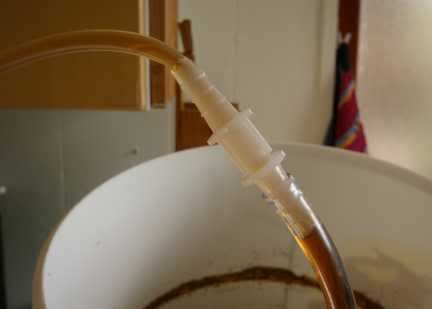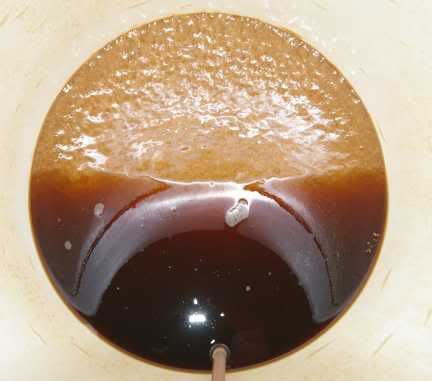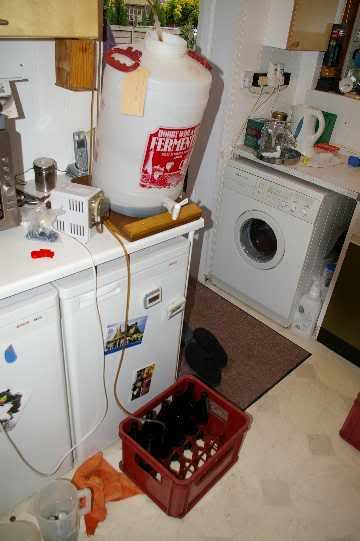Two new PID controllers to play with, and they both worked well in a water test on Sunday. I spent some of Tuesday making fitted jackets for the two Electrim boilers out of bubblewrap, and I removed the horrible simmerstats from the boilers and just put a nut on the end of each of the stainless screws left behind (there is a little rubber washer for waterproofing).
Wednesday morning (bright, freezing cold) I realised I needed another kettle lead, having removed the Electrim giblets. Stole the undo-able hot-condition IEC plug off the now unwanted simmerstat.
3kg pale malt
500g crystal malt
100g Melaninoid malt
100g roasted wheat malt
300g roasted rolled oats (= 263g after roasting for 45 mins at Gas Mark 5 - Vossy's recipe says 1 hour at Gas 5, but after three goes of 15 mins with stirring in between, I thought it was starting to smell a bit well-done round the edges).
before roasting:
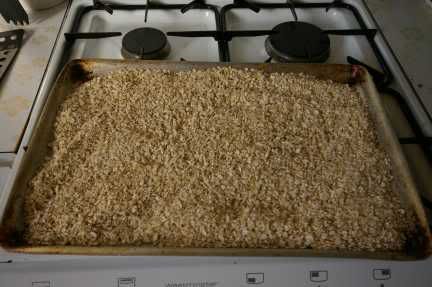
after roasting:
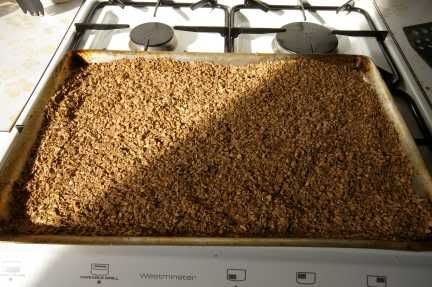
The light has changed, so it's a bit difficult to see the colour change.
Tried to mash with electric pump recirculation: here is a new plastic garden hose manifold from Wilko's which I fondly imagined would direct the recirculating liquor around the mash tun, agitating the mash:

and here is the setup:
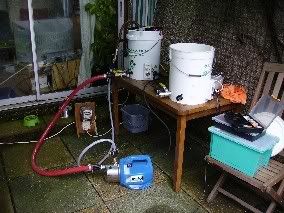
Distinctly NG owing to trying to mash with no grain bag, so pump and tubing and bottom of boiler clagged up with grains. I think the big pump may have sucked the grain past the false bottom, bending it in the process! Here is the pile of grain in the bottom after I'd taken out the false bottom:
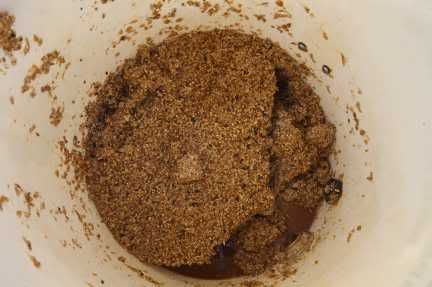
Sorted out clagging, put grain in grain bag, tried to mash without recirculation.
About an hour at 40 ̊C while messing about - supposed to be the beta-amylase rest so the malt can deal with the starchy oats - I’d meant half an hour, but...
The element started cutting out. Good news - the kettle elements I got from my local hardware shop - “These are the last of them from the warehouse you know†- cut out and in again once they’ve cooled down, rather than the original ones with the Electrim mash bin which die and are dead if they overheat. However I was round the back with the multimeter seeing if the element was conducting or not: the 2.2kW element reads 26 Ohms when on, and infinity when it isn’t. I do need that element-is-OK-lamp as mentioned in my PID post. Really!
Put a clean element in, put the grain and the liquor/wort back in, and found the wort dribbling out of the bottom because I’d forgotten the white rubber ring to go between element and boiler. Take the liquid and solids out, remove the element, wipe the hole, put the element back with the rubber ring this time. The clean element was also cutting out because the gluey stuff from the oats and the crystal malt was burning onto the element.
OK, how can I heat that much grain and liquor without direct heating from an element? Aha... need a heat exchanger! Brewery reconfigured as HERMS lashup instead of RIMS using the home-made immersion chiller, the boiler as an HLT and a selection of hoses and adaptors.

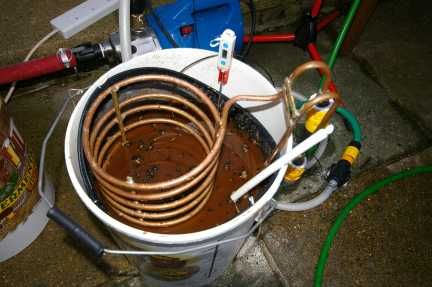
You can see the little black wire of the PT100 probe next to the thermometer. A tap from a fermenter was put into the bottom of a brewing bin so the bin could be used as the mash tun, and have somewhere to run-off from (not playing with hop-backs at this stage). I put a kitchen sieve under the return pipe into the HLT to catch the grains which were still coming out of the pump. Note quantities of valuable wort on the patio! At this stage after the sort-of 40 ̊C bit, my new cheapo refractometer was reading 9 ̊ Brix, which the table on Fermsoft makes 1.036. I could brew with that, apart from it being rather murky like lentil soup. I haven't understood whether I need to do anything about temperature compensation with the refractometer. It says it has ATC, but is that the surroundings or the sample?
After a while the brewing bin spat the tap out of its hole and started pouring wort onto the patio. I'd used the rubber washer which worked with the fermenter, but the new hole in the brewing bin was 28mm (I have a hole-saw that size) instead of the 1" it really wanted. Take the liquid and solids out, including the false bottom, remove the tap, wipe the hole, put the tap back with two big plastic tank washers and a quantity of silicone sealant (from Wickes. Fernox do something similar. WRAS-approved, good for potable water and hot water to over 100 ̊C, goes off in 20 minutes or so - the tube comes in a red box). Have a cup of tea and a sit down while waiting for the sealant to go off, also dry socks not soaked in sticky stuff.
Now we have the big pump doing a million gallons a minute through 8mm copper pipe (spot of back-pressure here), via some garden hose which didn't want to stay on its nice Gardena-style hose fitting once the circulating water was getting hot. I tried another fitting, but after the second time that it blew off and sprayed me with hot water, I went straight from the reinforced silicone hose to the Gardena fitting without any garden hose in the way.
Other people posting to JHBF have pointed-out the difficulty of controlling the temperature of a HERMS with a big HLT. I have to agree! It took about 2 1/2 hours to go from 30 ̊C to 63 ̊C with the single kettle element in the HLT - somewhere about this point I'd decided to give up on the 50 ̊C rest. About 5 pm I was ready to give up entirely, but the thought of all that nearly-beer was too much. With the PID set to 68 ̊C I was eventually getting mash at 61 ̊C according to the thermometer, so I turned the PID up to 75 ̊C, chucked in several kettlefuls of boiling water into the HLT and got 67 ̊C! Hooray, start the timer for one hour. Without the mash circulating I had to stir it every so often, particularly to get the hottest fluid nearer the thermometer and the probe - that's why I would like the mash to be all whizzing around under power. Several hot hose adjustments and a scalded hand (should have worn the rubber gloves) later... I realised that the mash temperature had crept up to 73 ̊C, and thought Rude Word, as my auntie would say. It must have had about half an hour at that temperature. With ten minutes of the mash to go, the other piece of garden hose blew - but splitting instead of coming out of the hose fitting. More hot water all over the show. Gave up on the heating and circulating for the last ten minutes. Ran off into a clean bin, and sparged with the other PID system:
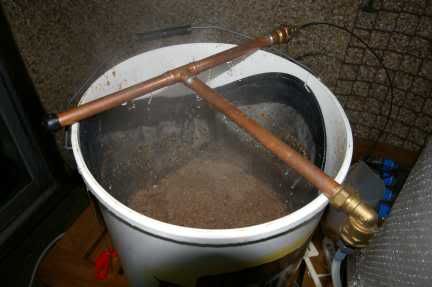
You can see the PT-100 probe in the end of the sparging tee. I used a little bit of self-amalgam tape instead of the olive in the Watch Hill 3mm to 1/8 BSP fitting, which I adapted to 15mm copper. Here are the PID controller and the peristaltic pump:
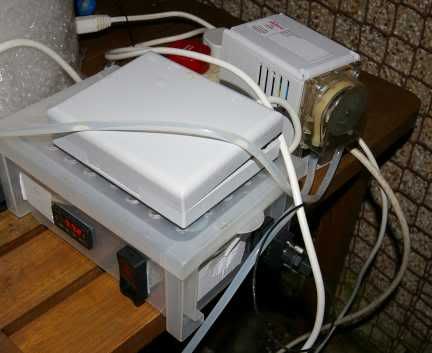
I think the sparging went brilliantly: temperature at 77 or 78 ̊C, I moved the sparging tee around a bit to cover the grain bed, and stopped sparging when the run-off looked a bit anaemic (2 ̊ Brix, say 1.008).
Boiling went very well - about another hour to get up a rolling boil, with one element:

added 30g of home-grown Hallertau hops in a bag, boiled for an hour, put the (cleaned-ish) immersion chiller in to sterilise, back to the boil, added 20g of home-grown Hallertau hops in another bag, boiled for a further 15 mins, force-chill for about half an hour to discover it had gone down to 15 ̊C (Rude Word), pour between sanitised brewing buckets to aerate, adding the starter of Safale S-04. The starter went up like a lift, so something went OK yesterday. Bucket sitting in the front room for a week or so, then I'll rack to a fermenter. OG 13 ̊ Brix = about 1.053?
Today I'm taking it easy - I reckon I was starting on the patio about 10:30 or 11 a.m. yesterday, and stopped washing up (didn't say I'd finished) about 11:30 p.m.
I'm sure I read on here somewhere that some expert homebrewer could do a all-grain in five hours! Maybe all his kit works...



